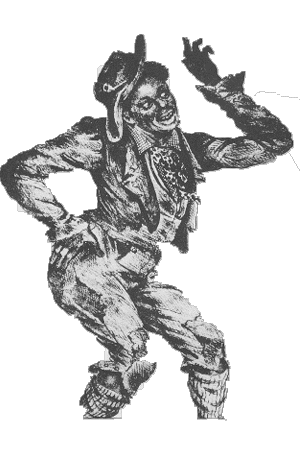 |
| George Primrose in Blackface |
| Wheel about, turn about, Do jis so, An, ebery time I wheel about, I jump Jim Crow (Ames 33). |
| Making an act out of tap |
| The year 1828 was to be when the first minstrel would encounter what was the very beginnings of tap dance. This professional dancer was one Thomas Dartmouth Rice. On a summer tour in Louisville, Kentucky with his theater company, Rice came upon a slave named Jim Crow after his owner. The slave was dancing, and was doing so as well as he could, considering his sustaining injuries to his legs and shoulder, and the song Crow sang as he danced was: |
| Inspired by Crow's act, Rice made note of his dance and wrote a few new verses to Crow's song. Later, he donned what would in the future be called blackface and performed the song and dance in front of a Louisville audience. The crowd loved it and Rice was a success. Blackface would later become a standard in minstrelsy, but Jump Jim Crow became an instant dance craze. |
| In the 1840's, white and black dancers were given the opportunity to exchange material in an area of New York City called Paradise Square. Here, where all dancers were on equal footing, the Irish jig met the native African dance and both converged in traditional Lancashire dance competitions. Most famous of these dance confrontations was that between John Diamond, an Irishman, and William Henry Lane, a black man who went by the name of Juba. Both were considered the greatest dancers of their respective backgrounds, but in this competition European influence went up against Negro influence and Juba came out the winner. He was thus crowned the "King of All Dancers" (Nash 5). Juba became an international sensation and was used as a model by many aspiring dancers. |
| Equally talented were the performers on the minstrel stage. Minstrelsy was important to tap dance not only because of Thomas Dartmouth Rice's contributions, but because, in the mid nineteenth century, it was where tap became a more specialized form of dance. It became more refined, more controlled, closer to the ground, and generally more sophisticated. Initially, the clog shoe was worn by tap dancers in order to produce a more enhanced sound. Dances were eventually split into two categories--fast versus slow. The dances that were taken at slower tempos came to be known as Essences. George Primrose, an Irishman from Canada, made a huge impact on the Essence when he gave up his clogs and began wearing leather-soled shoes--soft shoes. Very influential among his peers, Primrose made the Essence even more graceful and light with his new shoes, and his popularity made him the "master of the soft shoe well into the 1900's" (Ames 36). |
| Minstrel Shows were composed of three acts: Part I--the instrumental and vocal songs, casual banter, breakdowns, and stump speeches; Part II--the Olio, an assortment of virtuoso acts; Part III--the Southern plantation scenes and a "walk-around," a general smashing song-and-dance finale (Nash 6). Around the 1880's, the Minstrel Show began to wane. The second part of the performance--the Olio--began to dominate and soon minstrelsy faded away into the variety show better known as Vaudeville. |
| Whatever interaction black dancers had with white dancers in the days of Paradise Square was harder to come by in Minstrel Shows because blacks were not allowed to perform (although they often did so anyway, disguising themselves in blackface) and practically impossible to achieve in Vaudeville. Though Vaudeville presented a kind of democracy in music by throwing many and varied cultural acts into one night, this democracy existed only in favor of those of European descent. Vaudeville was by no means colorblind. There were two distinct Vaudevilles around the turn of the century: white vaudeville and the T.O.B.A. circuit. |
 |
| Thomas Dartmouth Rice |
 |
 |